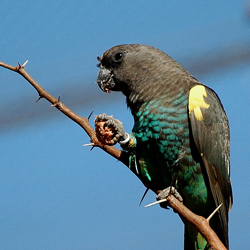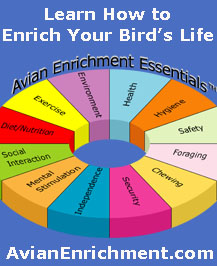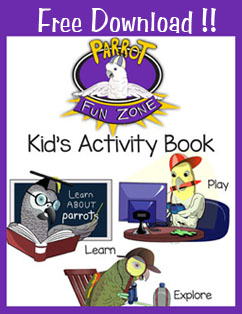Understand Your Bird's Body Language
 Birds have the ability to communicate with us in a variety of ways but the clearest insight we can get into our bird’s emotional status is via their body language. By taking the time to observe and interpret your parrot's body language, you will soon be able to easily discern when they are happy, want to play or eat, tired, angry, sick or even when they are about to poop!
Birds have the ability to communicate with us in a variety of ways but the clearest insight we can get into our bird’s emotional status is via their body language. By taking the time to observe and interpret your parrot's body language, you will soon be able to easily discern when they are happy, want to play or eat, tired, angry, sick or even when they are about to poop!
Gaining an understanding of the subtle clues your bird provides will enhance your relationship with your bird because you'll be able to earn his trust by respecting his moods and responding to his needs better. Not to mention, it will also reduce the likelihood of a bite which can be the result of approaching a bird and attempting to force an interaction (from the bird’s perspective) when it is feeling nervous, fearful or defensive. Ultimately, learning to correctly interpret your bird’s body language will result in less frustration for both you and your bird.
Body language can vary from species to species and even within a species but generalizations can be made regarding various body postures. Some signs are very clear, but many aspects of a bird's body language can be very subtle and many have dual meanings. Just looking at one aspect of a bird’s body language can be misleading. Correct interpretation often involves having to consider a combination of physical cues in conjunction with an evaluation of what is occurring in the bird’s environment.
For example, a bird with fluffed feathers could either be ill, cold, feeling relaxed or fearful. But, if the bird has fluffed feathers in combination with a fanned tail, dilated pupils and a wide stance then beware because this is a clear sign of aggression or defensiveness.
How to Recognize when your bird is.......
| Happy or content |
|
| Fearful |
|
| Aggressive or excited |
|
| Playful or eager |
|
| Flirty Bird |
|
| Disinterested |
|
| Relaxed |
|
| Sleepy |
|
| Sick |
|
Related Articles
 Health Matters
Health Matters
 Why Does My Bird Bite?
Why Does My Bird Bite?
 Why Does My Bird Scream?
Why Does My Bird Scream?
 Why Does My Bird Fluff Up?
Why Does My Bird Fluff Up?






































































